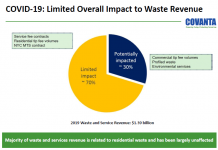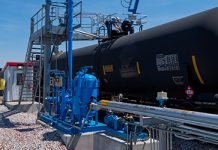by Jim Lane
In Delaware, DowDuPont (DWDP) announced that it intends to sell its cellulosic biofuels business and its first commercial project, a 30 million gallon per year cellulosic ethanol plant in Nevada, Iowa. The Nevada project is still going through start-up.
In an official statement, the company said:
As part of DowDuPont’s intent to create a leading Specialty Products Company, we are making a strategic shift in how we participate in the cellulosic biofuels market. While we still believe in the future of cellulosic biofuels we have concluded it is in our long-term interest to find a strategic buyer for our technology including the Nevada, IA biorefinery.
We will continue to participate in the overall biofuels market through specialty offerings including biofuel enzymes and engineered yeast solutions that improve yield and productivity for biofuel producers. We plan to work closely with local, state and federal partners to assure a smooth transition as we pursue the sale of the business. All affected employees will receive support services during this transition.
The local impact
The Nevada plant will be ‘kept warm’ but not operated going forward until a buyer is found. 90 workers are currently employed at the plant, and it can be assumed that this will be reduced to a skeleton staff until a buyer is found.
The strategic rationale
Ever since the Dow and DuPont merger was announced, there have been concerns about exactly where the cellulosic ethanol technology would fit in a company which avowedly planned, post-merger, to divide itself into three companies — one based on traditional chemicals, one on agriculture, one on speciality products and including the industrial biosciences.
As DowDuPont’s chief for Industrial Biosciences, William Feehery, explained to the Digest, “as we are racing to create an independent speciality products company, we came to the conclusion that this business just doesn’t really fit that [new] company. The second-gen business has a long, complex supply chain. It is a licensing business versus where we are going. And fuels are not a speciality product.”
What else is affected?
Nothing, DuPont’s 50 percent interest in Butamax technology remains, and as the company noted, its substantial enzymes and engineered yeast business lines for first-generation ethanol remain in place — as does its ongoing and successful biomaterials business.
The drivers?
It’s been a bumpy road for cellulosic fuels and BIO estimates that more than $14 billion in potential investment into the sector has been delayed or killed forever by US policy certainty with respect to cellulosic ethanol mandates. In DowDuPont’s case, Feehery emphasized that the internal evolution of DowDuPont was the basis for the decision to exit cellulosic.
“We still have a strong enzymes and yeast business and we are very committed to the [biofuels] sector, and we continue to strongly support the RFS,” said Feehery.
The state of the technology
Feehery told The Digest that the Nevada plant remains in its start-up phase and that it was too early to be discussing rates and yields, but confirmed that the company had commenced operating the plant but had not progressed to the distillation step where finished fuels are created. “We simply hadn’t taken that final step, as we have been focused on starting up the plant,” he said.
The Nevada project, in pictures
We profiled the project back in September 2014, as DowDuPont neared completion of construction at its 30 million gallon cellulosic ethanol plant in Nevada, Iowa, which became the world’s largest cellulosic biofuels refinery based on nameplate capacity.
See it in video
The project in Nevada, Iowa was the subject of a Digest documentary in its series, The New Places, which is available for streaming, here.
The industry impact
The announcement comes at a time of tremendous strategic shift in the cellulosic biofuels sector.
This week, Beta Renewables announced shutdown of its plant in Crescentino, Italy as the debt-laden company seeks to restructure itself. Meanwhile, Fulcrum Bioenergy priced its municipal bonds and gave the green light to commence construction of its first commercial. Clariant announced in the past 48 hours that it would embark on a second commercial-scale project off its own balance sheet.
And just two weeks ago on the ABLC Next stage, POET-DSM said that it had resolved a major pre-treatment bottleneck in its technology and re-affirmed its commitment to cellulosic technology. In September, Enerkem announced that it had commenced producing cellulosic ethanol at its first commercial plant in Edmonton, Alberta. Raizen said in July that it would scale-up its cellulosic deployments five-fold by 2018.
Meanwhile, a new generation of small cellulosic plays, based on unlocking cellulosic sugars in corn fiber that came in to traditional corn ethanol plants — had been gaining multiple customers for the likes of QCCP and Edeniq.
The Bigger they Are, the Harder They Fall
Just a few years ago, industry insiders were celebrating the fact that major players like Grupo M&G, BP, DuPont and Abengoa (ABGOY) were bringing forward technologies and building first commercials off their own balance sheets.
Yet, we’ve seen the flip side now. Abengoa crashed under a pile of solar-based debt. Grupo M&G’s chemicals business foundered and debt levels became a problem. BP went through the nightmare aftermath of the Deepwater Horizon oil spill. Now, DuPont has merged into DowDuPont and the company is about to be split into three entities.
The next owner?
It could be a tough sell.
BP found this out when it decided to put its technology up for sale prior to having a fully commercialized plant running. BP had to shut everything down and never did find a buyer. DowDuPont’s technology reached a much more advanced stage — plant constructed, and in start-up. But it’s two years since the company officially unveiled the project and nearly three years since much of the construction was complete. There are issues that DowDuPont is not discussing publicly about getting to steady-state operations — issues that a buyer will want to understand.
Many eyes may turn in the short term to Shell, which took a strong interest when the Abengoa plant came onto the market. In that chase, Synata Bio came up with the top bid. But that was for a project and a site, not for the technology. We’ll see which companies may have an appetite for the cellulosic ethanol business and need a full suite of supply-chain, plant and technology, and a desire to be have a project in the US market.
Given the number of competitors still out there, with Beta Renewables also for sale, and the state of technology readiness, the pickings may be slim and consequently the transaction price may be very low compared to DowDuPont’s investment to date.
The Bottom Line
In the end, the cellulosic ethanol project was uniquely fitted to the old DuPont — with its strong agricultural ties through Pioneer, its chemical plant expertise and its mastery of industrial biotechnology. When shareholders demanded a new configuration to unlock more value from Dow and DuPont, the writing was on the wall. The company has traveled a long road in this journey, and hard questions will be asked about the wisdom of it all. But the bottom line is that cellulosic was an orphan in the new three-company configuration that DowDuPont will become.
So let’s absorb this development, and move on.
The cellulosic ethanol industry’s focus must quickly shift to players such as Enerkem, Raizen, POET-DSM and Clariant which have doubled down on their cellulosic plans in recent weeks and months — or emerging drop-in options from the likes of Fulcrum BioEnergy, CRI, Virent, REG Life Sciences (REGI). DowDuPont must shift focus to finding a buyer for the cellulosic business and building on its strong business lines in enzymes, yeasts and biomaterials that will keep it a major player going forward. For the people closely connected to the Nevada project — policymakers, employees, growers — the focus must shift towards finding the right buyer for the long-term.
To each their tasks, then. The cards have been shuffled, and it’s a fresh deal. Players, look to thy cards and thy opportunities. Tomorrow is another day.
Jim Lane is editor and publisher of Biofuels Digest where this article was originally published. Biofuels Digest is the most widely read Biofuels daily read by 14,000+ organizations. Subscribe here.









Stover pickup is tricky. Timing vs harvest and drying vs rain. Dirt in pickup must be minimized. Equipment is custom, and crews must be scheduled. Storage sites must be contracted and prepared, enough in number to minimize fire risk, located to optimize put down and pick up distances. Not the “free” feed we once imagined. C4 production rates are half that of ethanol. Fuel value is better, but not double. Tax credits are unreliable. This business would be more profitable as a burn-stover-to-make-electricity model. Most of this was known in 2012, when the funding for the facility was being discussed. The dreams of licensing the technology have not materialized. What a waste.